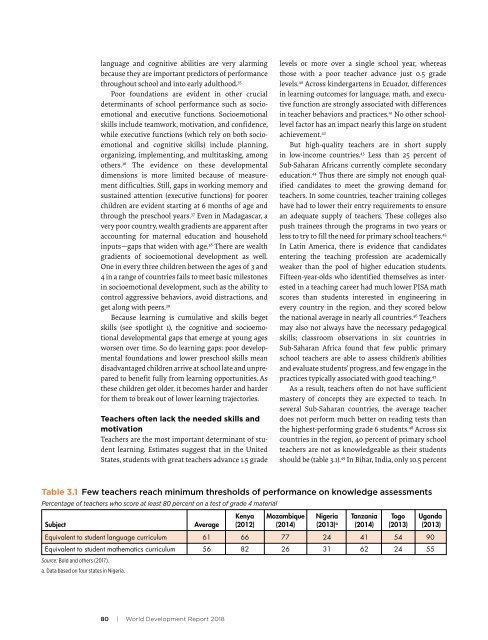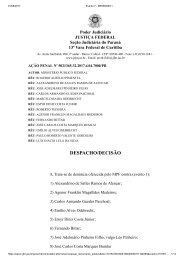Brasil só deve dominar Leitura em 260 anos, aponta estudo do Banco Mundial Relatorio Banco Mundial _Learning
You also want an ePaper? Increase the reach of your titles
YUMPU automatically turns print PDFs into web optimized ePapers that Google loves.
language and cognitive abilities are very alarming<br />
because they are important predictors of performance<br />
throughout school and into early adulthood. 35<br />
Poor foundations are evident in other crucial<br />
determinants of school performance such as socio<strong>em</strong>otional<br />
and executive functions. Socio<strong>em</strong>otional<br />
skills include teamwork, motivation, and confidence,<br />
while executive functions (which rely on both socio<strong>em</strong>otional<br />
and cognitive skills) include planning,<br />
organizing, impl<strong>em</strong>enting, and multitasking, among<br />
others. 36 The evidence on these <strong>deve</strong>lopmental<br />
dimensions is more limited because of measur<strong>em</strong>ent<br />
difficulties. Still, gaps in working m<strong>em</strong>ory and<br />
sustained attention (executive functions) for poorer<br />
children are evident starting at 6 months of age and<br />
through the preschool years. 37 Even in Madagascar, a<br />
very poor country, wealth gradients are apparent after<br />
accounting for maternal education and household<br />
inputs—gaps that widen with age. 38 There are wealth<br />
gradients of socio<strong>em</strong>otional <strong>deve</strong>lopment as well.<br />
One in every three children between the ages of 3 and<br />
4 in a range of countries fails to meet basic milestones<br />
in socio<strong>em</strong>otional <strong>deve</strong>lopment, such as the ability to<br />
control aggressive behaviors, avoid distractions, and<br />
get along with peers. 39<br />
Because learning is cumulative and skills beget<br />
skills (see spotlight 1), the cognitive and socio<strong>em</strong>otional<br />
<strong>deve</strong>lopmental gaps that <strong>em</strong>erge at young ages<br />
worsen over time. So <strong>do</strong> learning gaps: poor <strong>deve</strong>lopmental<br />
foundations and lower preschool skills mean<br />
disadvantaged children arrive at school late and unprepared<br />
to benefit fully from learning opportunities. As<br />
these children get older, it becomes harder and harder<br />
for th<strong>em</strong> to break out of lower learning trajectories.<br />
Teachers often lack the needed skills and<br />
motivation<br />
Teachers are the most important determinant of student<br />
learning. Estimates suggest that in the United<br />
States, students with great teachers advance 1.5 grade<br />
levels or more over a single school year, whereas<br />
those with a poor teacher advance just 0.5 grade<br />
levels. 40 Across kindergartens in Ecua<strong>do</strong>r, differences<br />
in learning outcomes for language, math, and executive<br />
function are strongly associated with differences<br />
in teacher behaviors and practices. 41 No other schoollevel<br />
factor has an impact nearly this large on student<br />
achiev<strong>em</strong>ent. 42<br />
But high-quality teachers are in short supply<br />
in low-income countries. 43 Less than 25 percent of<br />
Sub-Saharan Africans currently complete secondary<br />
education. 44 Thus there are simply not enough qualified<br />
candidates to meet the growing d<strong>em</strong>and for<br />
teachers. In some countries, teacher training colleges<br />
have had to lower their entry requir<strong>em</strong>ents to ensure<br />
an adequate supply of teachers. These colleges also<br />
push trainees through the programs in two years or<br />
less to try to fill the need for primary school teachers. 45<br />
In Latin America, there is evidence that candidates<br />
entering the teaching profession are acad<strong>em</strong>ically<br />
weaker than the pool of higher education students.<br />
Fifteen-year-olds who identified th<strong>em</strong>selves as interested<br />
in a teaching career had much lower PISA math<br />
scores than students interested in engineering in<br />
every country in the region, and they scored below<br />
the national average in nearly all countries. 46 Teachers<br />
may also not always have the necessary pedagogical<br />
skills; classroom observations in six countries in<br />
Sub-Saharan Africa found that few public primary<br />
school teachers are able to assess children’s abilities<br />
and evaluate students’ progress, and few engage in the<br />
practices typically associated with good teaching. 47<br />
As a result, teachers often <strong>do</strong> not have sufficient<br />
mastery of concepts they are expected to teach. In<br />
several Sub-Saharan countries, the average teacher<br />
<strong>do</strong>es not perform much better on reading tests than<br />
the highest-performing grade 6 students. 48 Across six<br />
countries in the region, 40 percent of primary school<br />
teachers are not as knowledgeable as their students<br />
should be (table 3.1). 49 In Bihar, India, only 10.5 percent<br />
Table 3.1 Fewteachersreachminimumthresholdsofperformanceonknowledgeassessments<br />
Percentage of teachers who score at least 80 percent on a test of grade 4 material<br />
Kenya Mozambique Nigeria Tanzania Togo Uganda<br />
Subject Average (2012) (2014) (2013) a (2014) (2013) (2013)<br />
Equivalent to student language curriculum 61 66 77 24 41 54 90<br />
Equivalent to student math<strong>em</strong>atics curriculum 56 82 26 31 62 24 55<br />
Source: Bold and others (2017).<br />
a. Data based on four states in Nigeria.<br />
80 | World Development Report 2018








